« Prev Next »
Introduction
Increasing human activities in the coastal zone create multiple stresses on estuaries that degrade water quality and damage habitats. Included here are the effects of eutrophication, wastewater inputs, chemical contaminants, freshwater diversions, draining and ditching of wetlands, hardened shorelines, sediment/turbidity influx, inlet stabilization, introduced species, and fisheries overexploitation. Single, cumulative, or synergistic processes linked to these factors can then lead to ecosystem dysfunction and serious depletion of resources (McLusky and Elliott, 2004; Adams, 2005; Borja et al., 2010). Some of the persistent drivers of change cause insidious decline of estuaries (e.g., eutrophication), whereas others result in acute impacts (e.g., large oil spills). Systems affected by anthropogenic stressors typically require extensive periods of time (up to 10–25 years) for complete recovery after the stressors are lifted (Borja et al., 2010). Restoration is a means by which estuarine habitat losses resulting from human activities and natural events can be mitigated and a system returned to a more improved pre-existing condition or state.
Restoration Defined
Livingston (2006) noted that science and engineering methods are typically brought to bear to return aquatic systems damaged by human activities back to some level of natural productivity. Borja et al. (2010) conveyed that the altered natural system is not considered to be recovered unless secondary succession returns the ecosystem to a pre-existing condition or state. The trajectory of such ecosystem recovery, however, depends on the scales of time, space, and intensity of anthropogenic disturbance. Thus, the process of recovery may follow one of three pathways: (1) passive restoration through ecological succession; (2) re-direction through active ecological restoration; or (3) unattainable recovery (i.e., ecosystem collapse) (Borja et al., 2010).
Duarte et al. (2009) asserted that, because of multiple shifting baselines, the restoration of coastal ecosystems to an idealized past reference status after removal of human-induced pressure is highly unlikely. For example, in the case of eutrophication restoration, damaged ecosystems displayed convoluted trajectories of recovery not directly reversible to reference ecosystem conditions. The impacted systems did not return to the original conditions tracking reversal trajectories as a result of broad changes in environmental conditions which significantly affected the ecosystem dynamics and restoration targets. Reliable targets of restoration efforts must be set based on clear understanding of ecosystem responses to the shifting baselines; identifying unequivocally the reference status to which a damaged ecosystem is supposed to return subsequent to reduction of pressures remains a formidable and largely elusive task. Targets that ensure the maintenance of key ecosystem functions and that supply constant valuable ecosystem services to society may be the preferred estuarine restoration strategy (Duarte et al., 2009).
There has been a long history associated with restoration of damaged estuarine environments (Kennish, 2000; Zedler, 2000, 2001; Livingston, 2006; ), and restoration efforts have increased over the past several decades in concert with accelerating drivers of change linked to activities of an expanding coastal human population. As noted by Madgwick and Jones (2002) and Elliott et al. (2007), restoration is generally needed to overcome reductions in the following elements of an ecosystem: (1) habitat fragmentation; (2) habitat and species diversity; (3) population size, dynamics and range of species; and (4) goods and services. Restoration of estuaries may take various forms such as revegetating salt marsh, mangrove, and seagrass habitats, repopulating shellfish beds, removing contaminated bottom sediments and hardened shoreline structures, installing oyster reef substrate, re-establishing freshwater inflow, removing invasive species, and improving water quality of land runoff.
Tidal marsh restoration has been frequently attempted, as exemplified by ongoing work along the shores of the Delaware Estuary. Here, various measures are being taken to stabilize the eroding shorelines of tidal marshes using natural intertidal reef communities comprised of shellfish (e.g., mussels), coconut fiber biologs and mats, bagged culch, and wooden stakes positioned at high and mid intertidal zones (Figures 1-6). Delaware Estuary tidal marshes are experiencing heavy inundation and erosion due to sea level rise, land subsidence, wave action, boat wakes, and other factors leading to rapid retreat in some areas. The long-term goal is to protect the shoreline and restore damaged marsh habitat (Partnership for the Delaware Estuary, 2008).
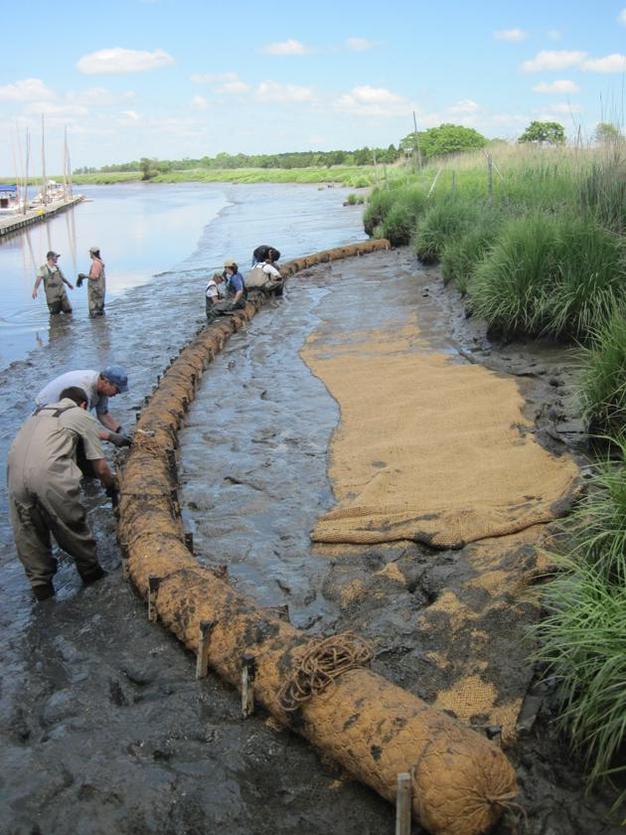
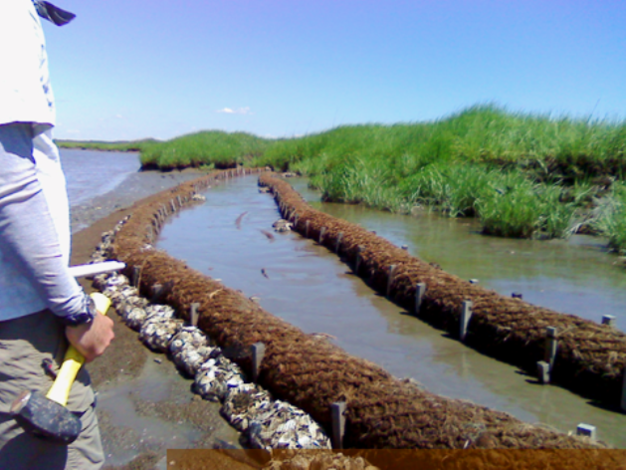
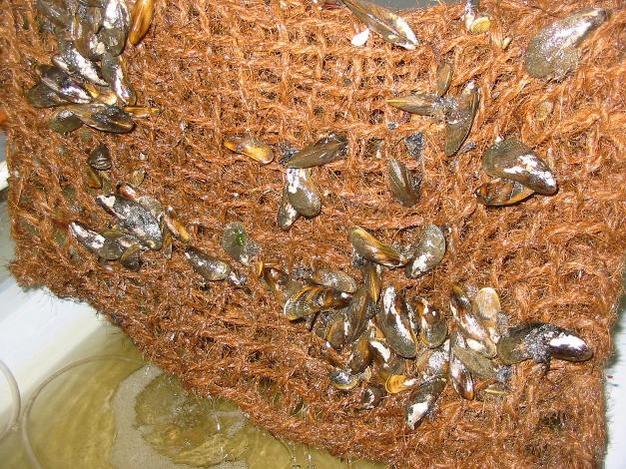
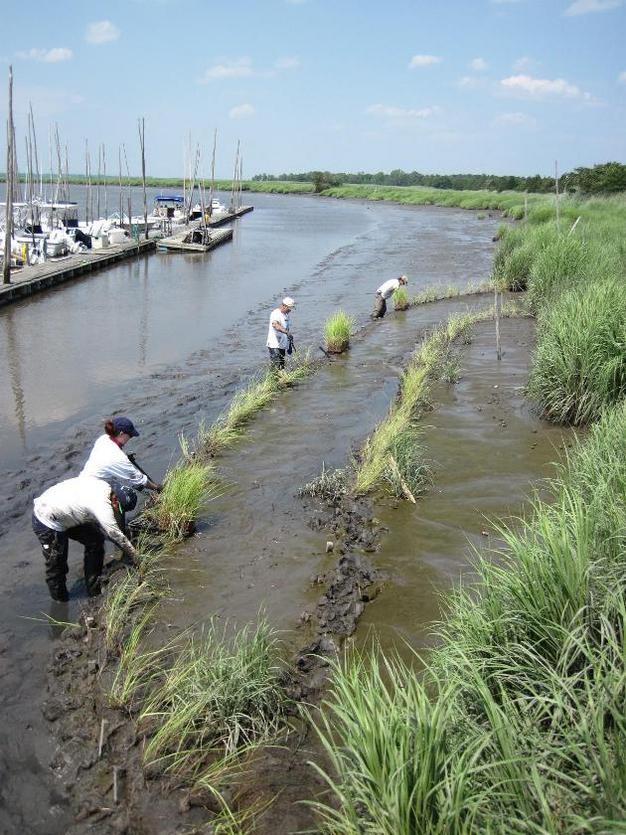
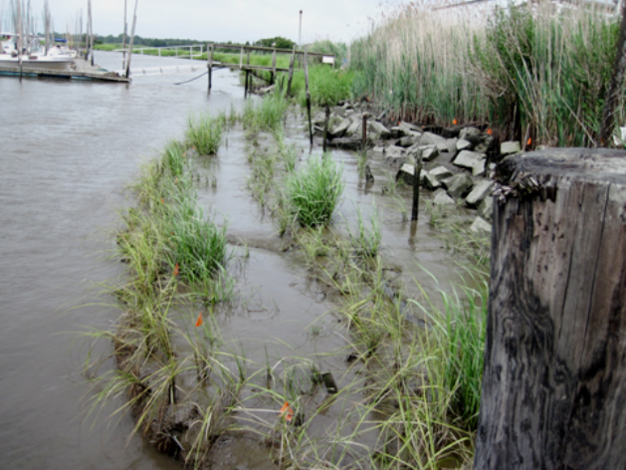
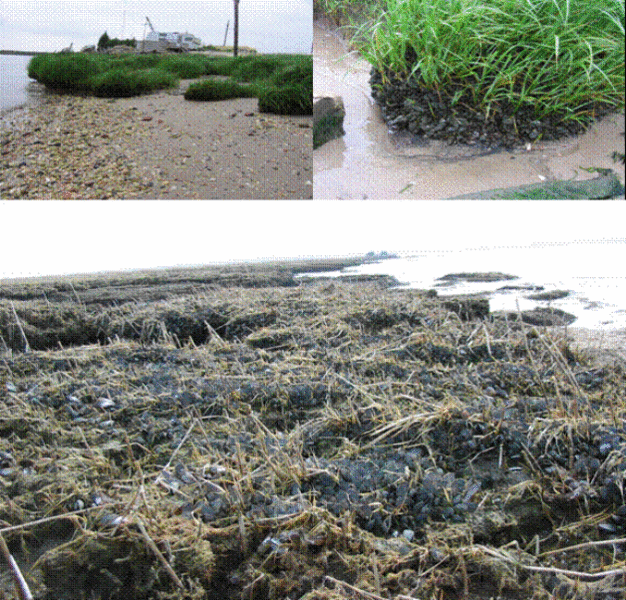
The success of restoration is assessed by how close the altered ecosystem returns to a pre-existing natural condition or state in terms of constituent flora and fauna, and habitats. There has been much greater success in the past at re-establishing structural components of damaged estuaries, while the restoration of ecological function and site fidelity has lagged behind. Re-establishing ecological function is critical to system sustainability.
Restoration Success
Elliott et al. (2007) examined the restoration of impacted biogenic reefs, salt marsh, seagrass, and upper estuarine water quality. They concluded that, although recovery techniques employed today are worthwhile, they rarely replace the habitat lost through human-mediated degradation. As noted by Elliott et al. (2007), these techniques are most successful in semi-enclosed coastal bays or lagoons, estuaries, and fringing habitats than in open coastal and marine habitats. Restoration targets are usually set by relating an impacted system to a historic reference habitat or biotic community, or by relating the impacted system to a nearby undisturbed reference location. The reference sites are also used for evaluating restoration trajectories (Steyer et al, 2003). Typically, restoration actions are not implemented on the scale of the entire estuary, but at a much smaller spatial scale amounting to tens or hundreds of meters of seafloor or shoreline, as in the case of oyster reef, seagrass beds, biogenic reefs, and salt marsh remediation (Grizzle et al., 2008). This can be a significant limitation since the cause of local as well as broader impacts may be coupled to ecosystem-wide drivers of change, such as eutrophication (Kennish et al., 2007; 2010).
Stochastic events (e.g., hurricanes, tsunamis, and earthquakes) can reset the restoration endpoint, thereby significantly altering the trajectories of recovery. In some cases, such natural disturbances can restructure the system in a way that it can never return to the reference condition. This should become evident when examining internal feedbacks over time and carefully monitoring the level of system degradation and rate of recovery (Zedler, 2000).
Recovery Rate
Borja et al. (2010) noted that the Nervioń Estuary in Basque Country, northern Spain has yet to recover from more than a century of urban and industrial development. Although substantial efforts have been made to reverse the ecosystem decline over the past 30 years through restoration and other actions, recovery has not been successful. While recovery of ecosystem structure may have been achieved, ecosystem functioning has not. It is unclear at present if the endpoint of ecosystem recovery can be realized.
Legislative Action
Conclusions
Alongi (1998) reported a seagrass restoration success rate of about 45% based on a literature review. The most successful seagrass restoration methods have included: (1) transplantation of 10- to 20-cm wide plugs of sediment, roots, rhizomes, and blades to the restoration sites; (2) transplantation of shallow plugs consisting of sods, turf, and grids to damaged sites; and (3) hand-planting of seeds. Of these methods, the use of plugs has been most successful, although in recent years, seeding has proven highly successful in the Virginia coastal bays in the U.S. For example, Orth et al. (2006, 2010) documented a substantial increase in eelgrass beds in these bays subsequent to nearly a decade of restoration efforts involving the broadcasting of seeds. The transplanting of eelgrass in this region, however, has yielded less promising results, with little success observed beyond 1 to 2 years (Orth et al., 2010).
Mangrove restoration has been most successfully achieved in Southeast Asia (e.g., Vietnam, Indonesia, Malaysia, and Thailand) by outplanting young or mature trees, as well as propagules. While outplanting of trees increases the probability of restoration success, it is far more expensive than the use of propagules. Achieving structural success at a mangrove outplanting site is less problematic than achieving functional success relative to reference locations.
The most extensive wetlands restoration projects in the U.S. have involved salt marsh systems. Typically, spatially localized tracts of salt marsh vegetation are restored in degraded areas. It is difficult to address the dynamic nature of salt marsh habitats, and thus it often takes years for the constructed marsh to approach the structural and functional characteristics of natural marshes in the same area. For example, the hydrological, chemical, geomorphological, and soil characteristics of the salt marsh habitat are highly variable and therefore extremely difficult to replicate. The ecological conditions of the restored marsh are so variable that more than a decade of time may be required for comparable biotic communities to re-establish. More research and restoration activities must be conducted in both degraded and reference systems to improve restoration success.
References and Recommended Reading
Adams, S. M. Assessing cause and effect of multiple stressors on marine systems. Marine Pollution Bulletin 51, 649-657 (2005).
Alongi, D. M. Coastal Ecosystem Processes. Boca Raton, FL: CRC Press, 1998.
Aubry, A. & Elliott, M. The use of environmental integrative indicators to assess seabed disturbance in estuaries and coasts: Application to the Humber Estuary, UK. Marine Pollution Bulletin 53, 175-185 (2006).
Borja, A. et al. Overview of integrative tools and methods in assessing ecological integrity in estuarine and coastal systems worldwide. Marine Pollution Bulletin 56, 1519-1537 (2008).
Borja, A. et al. Medium- and long-term recovery of estuarine and coastal ecosystems: Patterns, rates and restoration effectiveness. Estuaries and Coasts 33, 1249-1260 (2010).
Craft, C. et al. Fifteen years of vegetation and soil development after brackish-marsh creation. Restoration Ecology 10, 248-258 (2002).
Duarte, C. M. et al. Return to neverland: Shifting baselines affect eutrophication restoration targets. Estuaries and Coasts 32, 29-36 (2009).
Elliott, M. et al. Estuarine, coastal and marine ecosystem restoration: Confusing management and science — a revision of concepts. Estuarine, Coastal and Shelf Science 74, 349-366 (2007).
Grizzle, R. E. et al. Seston removal by natural and constructed intertidal Eastern Oyster (Crassostrea virginica) reefs: A comparison with previous laboratory studies, and the value of in situ methods. Estuaries and Coasts 31, 1208-1220 (2008).
Hering, D. et al. The European Water Framework Directive at the age of 10: A critical review of the achievements with recommendations for the future. The Science of the Total Environment 408, 4007-4019 (2010).
Jones, H. P. & Schmitz, O. J. Rapid recovery of damaged ecosystems. PLoS ONE 4, e5653 (2009). doi:5610.1371/journal.pone.0005653
Kennish, M. J. ed. Estuary Restoration and Maintenance: The National Estuary Program. Boca Raton, FL: CRC Press, 2000.
Kennish, M. J. Environmental threats and environmental future of estuaries. Environmental Conservation 29, 78-107 (2002).
Kennish, M. J. et al. Barnegat Bay-Little Egg Harbor Estuary: Case study of a highly eutrophic coastal bay system. Ecological Applications 17, Supplement, S3-S16 (2007).
Kennish, M. J. et al. "Environmental future of estuaries," Aquatic Ecosystems: Trends and Global Prospects, 188-208, ed. B. Polunin. Cambridge, UK: Cambridge University Press, 2008.
Kennish, M. J. et al. "Seagrass decline in New Jersey coastal lagoons: A response to increasing eutrophication," Coastal Lagoons: Critical Habitats of Environmental Change, 167-201, eds. M. J. Kennish & H. W. Paerl. Boca Raton, FL: Taylor and Francis, 2010.
Latimer, J. S. et al. Environmental stress and recovery: The geochemical record of human disturbance in New Bedford Harbor and Apponagansett Bay, Massachusetts (USA). The Science of the Total Environment 313, 153-176 (2003).
Livingston, R. J. Restoration of Aquatic Systems. Boca Raton, FL: Taylor and Francis, 2006.
Lotze, H. K. et al. Depletion, degradation, and recovery potential of estuaries and coastal seas. Science 312, 1806-1809 (2006).
Madgwick, F. J. & Jones, T. A. "Europe," Handbook of Ecological Restoration, 32-56, eds. M. R. Perrow & A. J. Davy. Cambridge, UK: Cambridge University Press, 2002.
McLusky, D. S. & Elliott, M. The Estuarine Ecosystem: Ecology, Threats, and Management, 3rd ed. Oxford, UK: Oxford University Press, 2004.
NOAA (National Oceanic and Atmospheric Administration). Habitat restoration. Silver Spring, MD: NOAA, 2008.
Orth, R. J. et al. Seagrass recovery in the Delmarva coastal bays, USA. Aquatic Botany 84, 26-36 (2006).
Orth, R. J. et al. Eelgrass (Zostera marina L.) in the Chesapeake Bay region of mid-Atlantic coast of the USA: Challenges in conservation and restoration. Estuaries and Coasts 33, 139-150 (2010).
Palmer, M. A. Reforming watershed restoration: Science in need of application and applications in need of science. Estuaries and Coasts 32, 1-17 (2009).
Partnership for the Delaware Estuary. Delaware Estuary Living Shoreline Initiative Fact Sheet. Wilmington, DE: Partnership for the Delaware Estuary. "http://www.delawareestuary.org/science_projects_living_shoreline.asp" (2008).
Plutchak, R. et al. Impacts of oyster reef restoration on primary productivity and nutrient dynamics in tidal creeks of the North Central Gulf of Mexico. Estuaries and Coasts 33, 1355-1364 (2010).
Steyer, G. C. et al. A proposed coast-wide reference monitoring system for evaluating wetland restoration trajectories in Louisiana. Environmental Monitoring and Assessment 81, 107-111 (2003).
U.S. Environmental Protection Agency. River Corridor and Wetland Restoration. Washington, DC: EPA, 2003.
Vitousek, P. M. et al. Human domination of Earth's ecosystem. Science 277, 494-499 (1997).
Williams, M. R. et al. Long-term trends of water quality and biotic metrics in Chesapeake Bay: 1986-2008. Estuaries and Coasts 33, 1279-1299 (2010).
Zedler, J. B. Progress in wetland restoration ecology. Trends in Ecology and Evolution 15, 402-407 (2000).
Zedler, J. B. Handbook for Restoring Tidal Wetlands. Boca Raton, FL: CRC Press, 2001.































